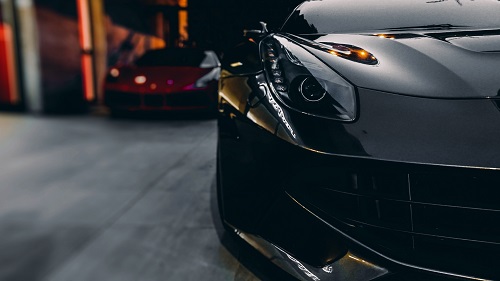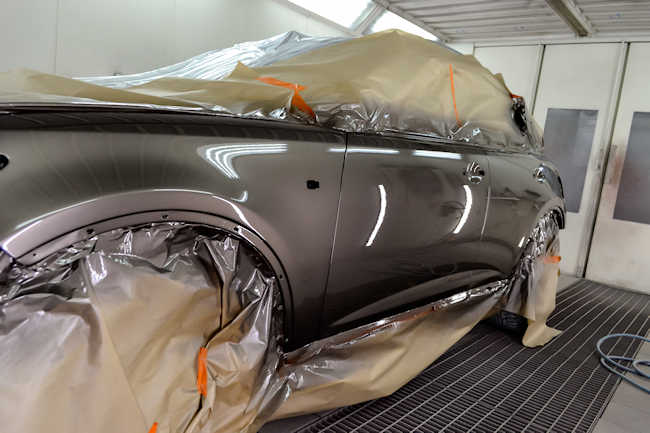 How to achieve a beautiful bodywork clearcoat ?
How to achieve a beautiful bodywork clearcoat ?
Here is an essential article that will be useful to many of you who read us and who are taking your first steps in the art of covering and varnishing a paint , both in the context of the renovation of a car collection, "custom" decoration of a car, a motorcycle, a helmet or a bicycle, or even objects or sculptures.
The final stage of varnishing is the most crucial and important stage. It's kind of the icing on the cake and the culmination of a lot of effort through the application of all the previous layers, from the primer, the preparation, to the paint. The art of varnishing consists in applying the varnish in a perfect way, so that the color is sublimated and the surface is perfectly smooth and shiny. The varnish makes the particles of mica and aluminum shine and sparkle, without it the colors would be dull and dull.
Achieving a beautiful bodywork varnish not only creates a durable and effective protection against corrosion that can attack metal parts, but it also helps protect the colors against light, heat, dust, fuels and friction or abrasion.
Successful car polish requires practice of the technique. It is also important to know your product well, because each automotive varnish is different and applies differently, behaves differently. Each painter has 1 or 2 favorite varnishes, which he masters perfectly and with which he knows that he has less risk of having a bad surprise. You can also have a very high-end varnish that you reserve for exceptional projects.
The art of varnishing : the qualities of a clearcoat
A good automotive clearcoat should be easy to apply and easy to achieve. A very good bodywork varnish allows you to obtain a shine even with a bad applicator, by exaggerating a little. What is true is that an excellent car clearcoat can be successful in both high and low temperatures, without excess of course, because when it is too cold, a varnish will take too long to dry and the risk sag is unavoidable. Otherwise, when temperatures go above 35°, it can affect the shine.
Let's now talk about the advice for properly understanding the technique and the art of varnishing : it is good to start with a little theory and even if it is a bit daunting, it is interesting to read and take note of the content of the data sheet.
Then, practice, because beyond the technical sheet, the rules remain the same for most clearcoats. Today, HS varnishes have almost completely disappeared and mainly more than UHS clearcoats are used. Either way, two coats should be applied. For an HS clearcoat, you must apply 2 full coats, while for a UHS clearcoat, you should in theory apply a medium coat, then a full coat.
The aim of applying the clearcoat is to obtain a layer which, after drying, will measure approximately 50 microns in dry thickness. A UHS clearcoat contains more dry matter and less evaporable solvent, therefore less product needs to be applied.
So, can you apply more layers if you want to get more thickness ? Not at all, because it does not give good results. In general, maximum and optimal shine is achieved in two coats. What happens when you try to apply a third coat, then a fourth coat, if you can do it of course, is a reduction in gloss. Indeed, the thickness that the solvents will have to cross in order to be able to come out and evaporate will be too great and there is always the risk of modifying the surface condition of the clearcoat. The same thing happens when the temperature is too high.
 The 4 fundamental rules for obtaining a beautiful bodywork clearcoat
The 4 fundamental rules for obtaining a beautiful bodywork clearcoat
1/ Apply the right amount of product : it's very easy to understand, because if you apply too much clearcoat, you get a run, while on the contrary, if you apply too thin a coat, then the varnish will not be able to stretch and shine. This is a matter of experience and it is easier said than done.
2/ Work in the right atmosphere (average temperature and low humidity). If you want to have a good shine and good drying, then you have to work around 20° and above all avoid damp environments at all costs.
3/ The distance and the angle of the gun which must always be 15 cm and 90°. Of course, the adjustment of the gun must be done correctly with a good pressure adjustment and a good adjustment of the shape of the spray pattern.
4/ The waiting time between each coat and the number of coats : in general, the interval necessary to cover a first coat is a waiting time of 7 to 10 minutes. Of course, this data must be modulated according to the ambient temperature and also the type of varnish, because there are varnishes that dry much faster than others.
Correction of defects with re-varnishing
It doesn't matter if you haven't successfully varnished it and some defects are present. It is always easy to correct these defects with polishing or the application of one or two new coats of clearcoat.
Wait 24 hours to allow the varnish to be completely dry and hard, then lightly sand with water to erase imperfections, orange peel, dust and then simply apply a single coat to regain a very high level of shine. The increased clearcoat thickness thus creates an impressive effect of transparency and wet look, especially when repeating this operation of applying new layers several times.
The technical sheet of a clearcoat
This document comes from the clearcoat manufacturer, shows some useful and interesting information. This sheet also includes essential information, such as dosage and mixing, or mixing time (Pot life). Only the information on the technical sheet is authentic.
The other information is suggestions : these are recommendations that each painter is free to interpret or change according to his preferences or according to the case and destination. Example : the suggestion of wet or damp thickness.
Some information is generally and unfortunately not taken seriously : this is the case with the recommendations for the preparation of the substrate. It is important to follow the recommendations, without interpreting or doing it your way, especially with regard to the fineness of the sanding.



















































































